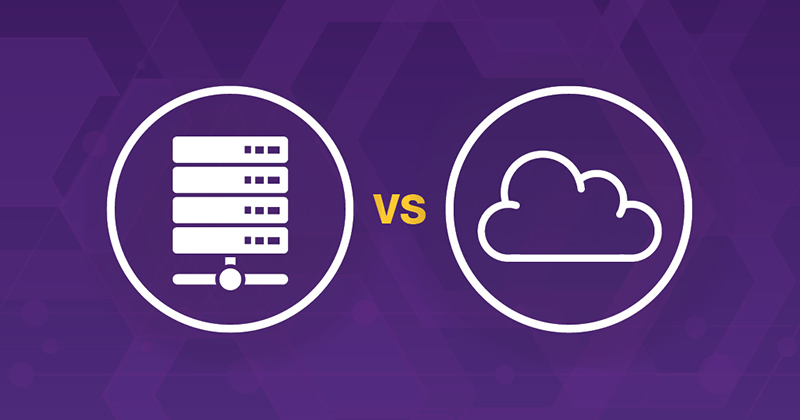A Server vs. Cloud Ophthalmology EHR

Why the difference matters when it comes to your ophthalmology software.
The terms “server” and “cloud” often get tossed around especially when describing the delivery method for ophthalmology electronic health record (EHR) systems. But do you really understand the differences and why, in my opinion, a cloud EHR is the way to go? In this post, I’ll define both types of software, share what it means for you and your practice, look at how both server and cloud models stack up and share a couple of client experiences, too.
What is server-based ophthalmology software?
In order to use a software program with an on-premise system, your computer must connect to a centralized computer—the server. Its job is to run the software and distribute it to computers like yours. Server-based software functions as a delivery model where you buy, install and maintain the servers on your premises to host your own “instance” of the application.
Now the question is, what does using a server-based software system mean for you? You would be responsible for managing and supporting items such as:
- Hardware
- Security
- Backups
- Hosting
- Interfaces
- Performance
- Database software
As if your job of being an ophthalmologist and a possible business owner aren’t enough, with a server-based EHR you now also have the responsibility of Chief Technology Officer. Or you have to hire one, which expands the budget. More to manage often means more headaches and detracts from time better spent on what you do best: caring for and treating patients.
What is cloud ophthalmology software?
Also known as Software as a Service (SaaS), cloud ophthalmology software is a delivery model where the vendor hosts the software on remote servers, and you, as a client, can access a multi-user environment through the Internet. By leveraging economies of scale, the vendor can host the software at a comparatively low cost. You may be thinking, that’s great for the vendor, but what does this translate to for my practice? The answer is a good deal of benefits. With a cloud EHR, there’s less hardware for you to buy, set up and manage. Plus, it’s easier to access data remotely, providing added mobility and flexibility to access patient records when away from the office.
With ophthalmology being such a visual specialty, I broke out the key components in the table below to show how a server and cloud option stack up. As you go through the chart, ask yourself some questions:
- Which would I prefer to deal with on a regular basis? The standard characteristics associated with a server or those of the cloud?
- What can my staff and I realistically manage in addition to our current roles? Or do I have the budget to hire another high cost employee?
- Which option will be the most cost effective long-term?
- Which option will have the ability to grow with me as my practice grows, too?
After you assess both options, I have a strong feeling that the winner and your answer will be quite clear.
COST-EFFECTIVENESS
| Server | Cloud |
|---|---|
| Larger upfront hardware and installation costs | Lower upfront hardware and installation costs |
| Hardware should be replaced every 3–5 years | Little to no hardware to replace |
| Large one-time software purchase can be a sunk cost | Lower upfront costs with subscription service |
CONVENIENCE
| Server | Cloud |
|---|---|
| During hardware setup, the practice may need to close | Since there’s virtually no hardware setup, the ophthalmology practice may be able to stay open during go-live |
| Managing multiple locations can be difficult and may require additional servers and hardware | Data syncs in real time across facilities; ophthalmology practices can add new locations easily without buying server hardware |
| Limited mobility with data stored on premise | Records accessible from almost any Internet-enabled device |
MAINTENANCE
| Server | Cloud |
|---|---|
| To support and maintain hardware, the practice may need its own IT team | Software is vendor supported, so the practice may not need additional IT resources |
| Updates may cost extra and require additional work to install manually | The ophthalmology software can update automatically through the cloud at no additional charge |
| Harder to scale—if capacity runs out, the practice needs to buy and install more hardware | Easier to scale—vendor expands capacity as needed |
SECURITY AND CODING
| Server | Cloud |
|---|---|
| Vulnerability to on-premise physical security issues like natural disaster and theft | Frequent backups, resilient storage, load balancing and multiple availability zones can protect data and provide uninterrupted service if a server fails or a physical disruption occurs |
| Increased potential for billing and coding errors if the software becomes out of date | Automatic updates to coding algorithms can be done in the cloud |
Based on my experience as both a former retina surgeon and now as an employee of a leading health IT company, a cloud ophthalmology EHR systems’ benefits far surpass any that come along with a server-based system.
Another Option: Application Service Providers
Another type of option I do want to briefly touch on is that of application service providers (ASPs). ASPs offer a hybrid “hosted” model, which deliver another vendor’s server software through the Internet. It’s less scalable than a true cloud system since they typically have a different database for each client, and installation and updates may require more work on your end as a practice. Also, a third party may not be able to meet your needs as well as the original vendor. In brief, I would rate it above a server-based model but it would fall far below the perks offered by a cloud EHR system.
A Word With Our Clients on Cloud Ophthalmology Software
Still not convinced cloud EHR software is for you? Read what our clients have said about our ophthalmology EHR, EMA™. Maria Ruttig, practice administrator at Eye M.D. of Niceville, shared the practice’s overwhelming positive experience by utilizing a cloud ophthalmology EHR system. “Being in the cloud makes the system easily accessible; our doctor can finalize charts from the comfort of his home. If patients call after hours and need a prescription, he can easily fill them electronically and make a quick progress note in their charts. This is an especially important component for MIPS. In general, our practice appreciates the convenience of having a cloud ophthalmology EHR system to improve communications with other providers and payors. Having the right technology in place is worth the investment to run a successful practice,” shared Maria.
Christine Sykora, practice administrator at Advanced Eye Care, SC, shared a similar sentiment in using our cloud ophthalmology EHR. “A benefit of our cloud ophthalmology EHR system is the documentation trail automatically left behind as staff and providers complete tasks. When relying on paper charts, a casual request made in the hall may never be recorded. Besides provider satisfaction, the speed and centralization of our cloud EHR system has helped improve the patient experience. We subscribe to a service that data-mines our clinical encounters nightly. Based on predetermined and provider-specific parameters, patients can be contacted by staff. This task alone would be impossible to conduct manually, especially on a nightly basis. Yet, it allows us to more easily facilitate the best possible care with respect to managing our patients’ diabetic eye exams, glaucoma pressure checks, dry eye disease or even annual contact lens exams,” stated Sykora.
